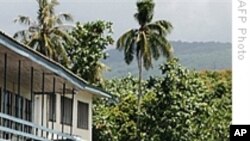A week after earthquakes and tsunamis caused hundreds of deaths in Indonesia and the Samoan islands, four new quakes have rattled the Pacific, far out to sea. A tsunami warning for 11 nations and territories, including Vanuatu and Fiji, was issued but later called off.
The United States Geological Survey says that a 6.7 earthquake occurred in the Pacific 280 kilometers from the Philippines early Thursday. Three others followed near the Pacific islands of Vanuatu including a 7.8 quake 294 kilometers northwest of the island of Espiritu Santo.
A tsunami alert for the region was issued but canceled two hours later after small waves hit some of the islands, doing no apparent damage. The warnings caused thousands of residents to flee to higher ground in several Pacific island states.
This latest tsunami warning comes just over a week after an 8.3 quake triggered a tsunami in Samoa and American Samoa that killed at least 178 people, and a 7.6 earthquake devastated the Indonesian island of Sumatra.
Dale Grant, a geophysicist with the U.S. Geological Survey says this spike in activity is not unusual.
"You might think of earthquakes as being cyclical," Grant said. "There are times when it is very quiescent or quiet, and then all of a sudden it will just ramp up and get busy, busy, and that is what we've seen over the last few weeks."
Grant says the earthquakes occurred far out in the Pacific Ocean, which is why the tsunami warning was issued. And he says they have not yet received any reports of casualties or major damage from the quakes.
John Nicholls, who operates a travel service in Vanuatu, described the most recent earthquake as routine.
"We felt a quake. We do have a lot of earthquakes around the year, but this was just another one, a bit of a shake," he said. "I was sitting at my desk and my keyboard moved a little bit. My chair moved a little bit, but we would have those types of tremors probably about 30 times a year. So we didn't pay much attention to it."
The U.S. Geological Survey says residents in these Pacific islands need to be prepared for future earthquakes and tsunamis because this region is the most active seismic zone in the world. Several tectonic plates collide in the Pacific, creating what is call the Ring of Fire, which stretches from the coast of the Americas to Japan in North Asia and the South Pacific islands.
News
Tsunami Alert Canceled After Series of Pacific Earthquakes
update

<!-- IMAGE -->






